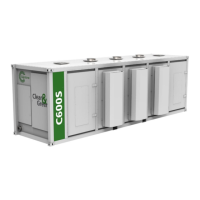Capstone Turbine Corporation • 16640 Stagg Street • Van Nuys • CA 91406 • USA
Installation Guide: Capstone C1000S/C800S/C600S with C1000 Series Controller
480064 Rev C (December 2018) Page 56 of 122
Capstone reserves the right to change or modify, without notice, the design, specifications, and/or contents of this document without
incurring any obligation either with respect to equipment previously sold or in the process of construction.
6. Fuel Delivery (Pipeline Natural Gas)
Capstone systems are generally designated by the type of fuel on which they are intended to
operate. Examples of approved fuels include pipeline quality natural gas, raw natural gas, biogas,
liquefied petroleum gas (LPG), and liquid fuels. Refer to Section 4.1 for fuel connection type,
thread details, and pressure requirements. Fuel quality requirements for Capstone microturbines
are provided in the Capstone MicroTurbine Fuel Requirements Technical Reference (Table 1).
Reliability of microturbine operation is based on the quality of the gas at the microturbine inlet.
This leaves the business partner and/or end-user responsible for the following:
Assessing the need for gas cleanup and conditioning
Selecting, installing, operating, and maintaining the appropriate gas cleanup and
conditioning equipment
6.1. Fuel Conditioning System
This section describes the components involved in a pipeline quality natural gas fuel conditioning
system. Other fuels have different requirements which are described in that fuel’s application
guide (Table 1).
Capstone is not responsible for the design, installation, or operation of fuel conditioning and
delivery systems. Proper maintenance of fuel delivery systems is necessary for normal
microturbine performance and routine maintenance intervals. Capstone recommends engaging
appropriately skilled personnel for the design and installation of fuel conditioning and delivery
systems as these can be particularly technically challenging applications.
Examples of pipeline natural gas installations are shown in Figure 25. Components outlined in
red are required for each microturbine in an installation. Components outlined in green vary by
application, local regulatory code, and site requirements. A filter at each unit allows for targeted
troubleshooting of condensation or piping problems. A regulator at each unit eliminates the
possibility of fuel pressure fluctuations and nuisance flameouts.

